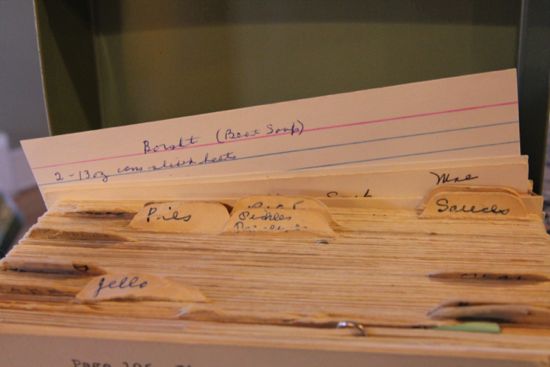
I woke up from a forgotten dream, but for the rest of the day I couldn’t stop thinking of my grandmother’s borscht. What is it about food memories? I hadn’t thought of this soup in decades, but then I couldn’t get it out of my mind. I knew every flavor in this soup before I found the recipe in the avocado green metal recipe box. And there was another word knocking around my head. Flanken.
 When Mary would make soup, and there were only six in her repertoire – matzo ball in deeply flavored chicken broth; split pea, no ham – maybe hot dogs; vegetable barley with beef; and beefy borscht. There were two exceptional cold soups, too, but with snow flurries, cold days and a stiff breeze, I’m focusing on the hot ones.
When Mary would make soup, and there were only six in her repertoire – matzo ball in deeply flavored chicken broth; split pea, no ham – maybe hot dogs; vegetable barley with beef; and beefy borscht. There were two exceptional cold soups, too, but with snow flurries, cold days and a stiff breeze, I’m focusing on the hot ones.
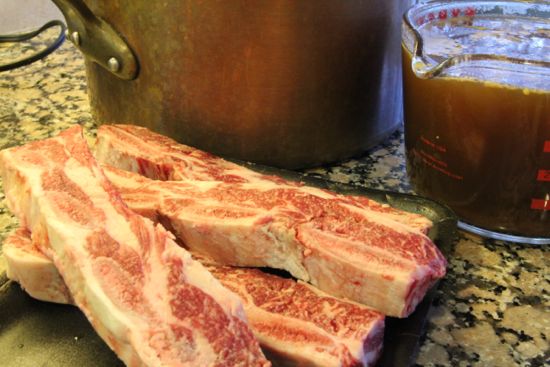 Flanken is a key ingredient in the two beef soup recipes in that little box much as other cultures might use pork. But not Mary, a tradition-bound Jewish cook, even though it had been decades since she kept Kosher. For her, flanken provided a deep flavor and a sturdy base for bone-sticking soups. She would ask the butcher for some “flanken,” and although she rarely spoke Yiddish, when she said this word, there was a certain tone, something that told me she spoke this word in another language first. In her native Lithuanian. The soups had the same quality. They spoke another language; all tasted of tradition even though I hardly understood that at the time.
Flanken is a key ingredient in the two beef soup recipes in that little box much as other cultures might use pork. But not Mary, a tradition-bound Jewish cook, even though it had been decades since she kept Kosher. For her, flanken provided a deep flavor and a sturdy base for bone-sticking soups. She would ask the butcher for some “flanken,” and although she rarely spoke Yiddish, when she said this word, there was a certain tone, something that told me she spoke this word in another language first. In her native Lithuanian. The soups had the same quality. They spoke another language; all tasted of tradition even though I hardly understood that at the time.
Flanken is cut from long ribs – the rail ribs. Picture a rack of ribs – the ones in the front of the animal are longer, to encompass the lungs and heart, then they get shorter toward the back. The shorter ones = short ribs. The longer ones? Rail ribs, or flanken.
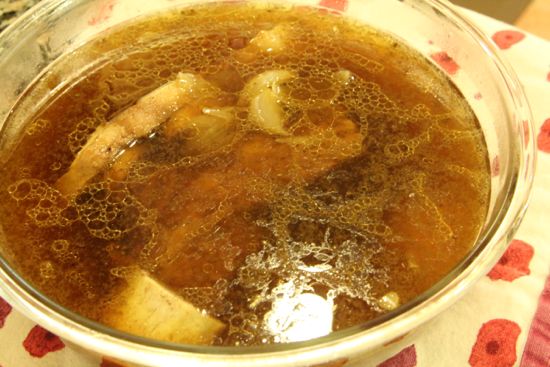 The bones are cut into slabs, right through, and each piece includes three or four round bones. By slicing the meat and bones this way, the butcher reveals the meat, the marrow and the connective tissue that makes for a gorgeous velvety rich soup. Flanken is not a short rib, but if you aren’t blessed with a butcher, and can’t get true flanken, the short rib will do.
The bones are cut into slabs, right through, and each piece includes three or four round bones. By slicing the meat and bones this way, the butcher reveals the meat, the marrow and the connective tissue that makes for a gorgeous velvety rich soup. Flanken is not a short rib, but if you aren’t blessed with a butcher, and can’t get true flanken, the short rib will do.
I could picture the meat, how she cooked it first in broth to defat everything before she made the soup. Once simmered for a few hours, we would pluck the meat, dispose of the small round bones, remove the strong fat binding the meat to the bone, and fill a bowl with tender shredded beef to enrich each bite of soup. This was work done with our fingers, not a knife, and therefore one of the first kitchen tasks I recall learning. If you have used short ribs, adjust the simmering times to accomodate the thicker pieces. The meat should be completely shreddable with a fork after simmering. Plan plenty of chilling time so the fat can be removed from the stock. (Lurking under that fat cap are the flanken… The marrow from the bones? Also added to the soup. Divine.)
 After the broth is strong and deeply flavored, it’s just a happy vegetable party – beets, carrots, cabbage and potato, along with a ridiculous amount of fresh dill. When the soup is done, the cabbage is meltingly tender and everything is tinged a happy deep red.
After the broth is strong and deeply flavored, it’s just a happy vegetable party – beets, carrots, cabbage and potato, along with a ridiculous amount of fresh dill. When the soup is done, the cabbage is meltingly tender and everything is tinged a happy deep red.
There was little doubt I would make the soup from the moment the memories flooded back. But my real intention was to can it. Pressure canning means this soup will be available whenever I wake up with thoughts of borscht.
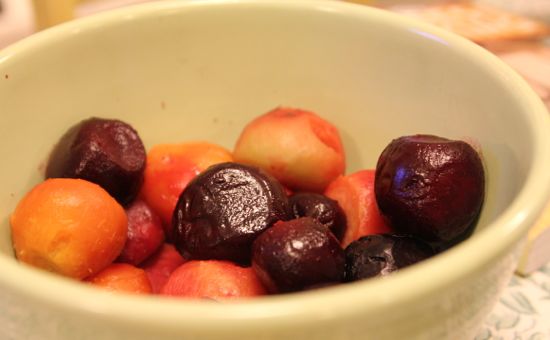 I roasted marrow bones to make a good beef broth first. And yes, I added shallots and red onions and grassfed beef, so there may have been some essential differences between Mary’s recipe and mine. In my heart of hearts, I was relieved it tasted just the same as hers, or as the memory of hers, because it was a tummy full of comfort every time I sat at her blue and white breakfast table and inhaled the steaming bowl of soup in front of me.
I roasted marrow bones to make a good beef broth first. And yes, I added shallots and red onions and grassfed beef, so there may have been some essential differences between Mary’s recipe and mine. In my heart of hearts, I was relieved it tasted just the same as hers, or as the memory of hers, because it was a tummy full of comfort every time I sat at her blue and white breakfast table and inhaled the steaming bowl of soup in front of me.
February 5th would have been my Grandmother’s 120th birthday. We think. But that’s a story for another day.
2 lbs. beets
3 quarts beef broth
1 -1/2 lbs. beef flanken
3 red onions, sliced into half moons
1 lb. carrots, peeled and sliced into discs 1″ thick
1 lb. (small) cabbage, shredded, but not too fine
1 lb. russet potatoes, peeled and chunked
2 cups red wine
10 stalks of thyme, 10 parsley stems, 2 bay leaves all tied together
2 Tablespoons kosher salt
1 teaspoon freshly ground black pepper
1/2 cup finely minced dill weed
Scrub the beets, wrap them in foil and roast for 40 minutes at 425°F. Allow the beets to cool, then peel and quarter them. Set aside.
In a pot wide enough to accommodate the flanken, add just enough broth to cover. Bring to a simmer, cover the pot and simmer for 90 minutes.
After simmering, strain and reserve the broth. Chill, then defat.
When the flanken is cool enough to handle, pick out the meat, shred it, and dispose of the bones and fat.
Add the onions, carrots, potato, cabbage, beets, herbs, salt, pepper and broth to a large stockpot. Simmer for one hour.
Add the beef and the dill weed and simmer for another hour.
Serve hot, with or without a tablespoon of sour cream floating on top.
Beef Broth
Makes 5 quarts
3 large beef marrow bones
5 large shallots, halved
4 garlic cloves, halved
4 carrots, halved
1 large celeriac, chopped into four pieces
3 Tablespoons tomato paste
12 black peppercorns
3 bay leaves
12 parsley stems
20 cups clean water
Preheat the oven to 425°.
Line a sheet pan with parchment. Spread out the bones, shallots, garlic, carrots and celeriac. Rub tomato paste all over the bones. Generously salt and pepper everything.
Roast the bones and vegetables for 40 minutes.
Add the roasted bones and vegetables and any collected juices to a large stockpot. Add the water. Add the peppercorns, bay leaves, stems.
Simmer for at least six hours, covered.
Strain and defat.
(To can for shelf stability, reheat the strained soup, ladle into pints or quarts, place lids and rings and pressure can at 11lbs. of pressure for 20 minutes.)
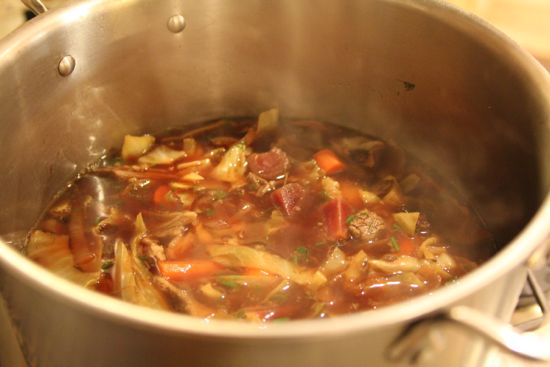








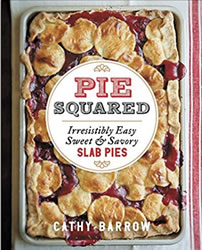

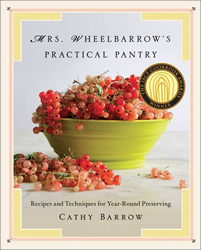
Sylvie
Thank you for this recipe. I will have to try this soon. It amazes me how many different cuts of meat there are and what a treasure it is to have a knowledgeable butcher. We are lucky here in DC.
I guess that is another reason why I love food so much. There is always something new to learn.
Cathy
Pam is the best
gluttonforlife
So THAT’S what flanken is! Just ate borscht at my sister-in-law’s last week and it reminded me that I shouldn’t let me husband’s dislike of beets keep them out of my kitchen. And yet another reminder that I can’t wait for your book so I can finally dispel the mysteries of pressure canning…
Cathy
My husband hates ’em, too. I snuck in golden beets once, carefully julienned. When he thought they were carrots, he loved them. Then… sigh… he figured it out. Oh, was I in trouble.
Zora Margolis
Really interesting article. I grew up eating beet borscht (cold) in the summer and cabbage and beef borscht without beets in the winter, although winters in Southern California don’t qualify as cold compared to ours in D.C. My mother was following the eating traditions that her parents and grandparents had brought with them to Canada from Belarus. Close enough to Lithuania to have many similarities, though with subtle differences. Sweet-sour is one. Your grandmother’s beef borscht will be sweetened by the beets, but her recipe doesn’t include any acid–although the addition of sour cream will supply a subtle tang. My mother’s/grandmother’s/great grandmother’s cabbage borscht recipe calls for lemon juice or sour salt (citric acid) which they would have used in the old country, where citrus fruits were unavailable. And sugar or honey. I don’t know when tomatoes started to be added, but my mother always added some canned whole tomatoes, coarsely chopped up. Having not tasted your grandmother’s borscht, I know it will be much beefier tasting than my mother’s, since it calls for making beef stock before cooking the borscht. My mother generally used a hunk of bone-in chuck or shank rather than flanken. And she cooked the meat together with all of the vegetables in water, until the meat fell apart. We always ate it with sour cream and dill, and rye bread and butter, and still do. I just made it last weekend!
Cathy
Zora – Thank you so much. I forgot the red wine. I remembered it when I made the soup, but forgot to put it in the recipe (fixed that now.) My grandmother’s recipe did not call for sour salt, but I’ve seen many that do, or vinegar. But when I was cooking, I smelled the soup, spied an open bottle of red wine, and thought, “oh, what the heck.” It mellowed the sweetness.
Carol Sacks
Lovely, evocative writing. And, I want that soup now.
VictoriaInMD
CSA pick up tomorrow and beets will be included in the winter veggie bounty. Can’t wait to make this soup, especially with snow forecast. Sounds scrumptiously comforting. Thanks!
Janis
I have been craving this soup and voila here is the recipe! Thank you thank you.
Larry Gaian
This recipe will be added to our list of recipes for Sunday Soup!
Kate Hill
I can hear the grandmothers above, comparing notes, judging our efforts, and clucking. I think I just heard how proud your grandmother was of you… Thanks for the lovely story and recipe using flanken! Can’t wait to try it.
Anne Ritchings
What a lovely post. thanks for sharing your memories and the recipes.
Madame Fromage
At long last, a borscht recipe with real personality. I’ve tried a few recipes in the past, but they never had the earthy depth I craved — they didn’t taste grandmotherly. This one looks sumptuous, if a borscht can have sex appeal? Flanken. Who knew? Thanks for a great post. I’ve been hearing about your blog forever, and I finally wandered over for a sniff sniff. Glad I did. Cheers!
edella
I still make a spring borscht for passover every year. You start a few months beforehand, and quarter beets and steep them in filtered water, being caareful it doesn’t get all furry. (But on the other hand it won’t ferment if you use those terrible biological cleaners)
Its done when the liquid is red and slightly tangy to drink. Its called rossel and is used as the liquid in a vegetarian borscht with the beets cut into small julienne pieces but just long enough to cook them tender so the colour doesn’t bleach out. You don’t need lemon juice etc, because the rossel supplies that taste I make enough for a crowd on the night, plus about four large preserving jars of beets plus liquid. A real spring specialty! It works best if you ferment a lot of beets — I usually use a covered pail, but a sauerrkraut crock would be ideal.
Julie Levitt
Edella,
I find this fascinating that a fermented food would be used for Passover. My grandparents on both sides came from Russia, so is this a custom from else where in Europe?
Rene
This sounds great, actually “mouth-watering” would be more descriptive. A question for you and your readers: what is white borscht? I was told it has oatmeal incorporated in it. Please advise.
Cathy
I’ve never heard of it, but wow. My grandmother made spinach borscht, a cold soup with a skim milk broth base (honestly, it’s fabulous, even though it sounds gross) so that was a white borscht – kinda. Never heard of incorporating oats, but that would be so so interesting. I’m going to do some research! Thank you, Rene.
Rene
Hi Cathy,
please let me know what you come up with. I was told about the white borscht by a Polish-American who said it was seasonal…. Easter time only. Hope this clue helps!
Laurie
That is a soup called “hobergrits”, which is Yiddish for oats. My grandmother used to make it and I do occasionally. Basically, oats, carrots, celery, onions and marrow bones.
Rene
Hi Cathy,
please let me know what you come up with. I was told about the white borscht by a Polish-American who said it was seasonal…. Easter time only. Hope this clue helps!
Rene
Kathy, I found it!
It is called Bialy Barszcz (Polish White Easter Borscht).
Here is a link that gives the recipe: http://www.saveur.com/article/Recipes/Polish-White-Borscht. No oatmeal in this reversion. Still sounds good.
Cathy
Rene, that looks just fantastic. I can’t wait to try it.
Catherine
Thank you so much for posting this recipe. It truly did remind me of the winter borscht we used to have as kids. I spent all day today cooking and canning this delightful soup and am now on the way to share it with the rest of my family at Thanksgiving dinner. I agree that the wine lends a depth to the broth that adds an amazing level of flavour to this dish. Again, thank you for sharing this gem!
Patricia Lerman
I made beef stock last night and winter borscht today, and I was thinking about how my grandmother would’ve used flanken.
Then I googled winter borscht and there was your post! Next time I will use flanken. The beef shanks I used were good, but not grandmother-great.
I used vegetables from our winter garden: parsnips, carrots, leeks, potatoes, fennel. cabbage, and red and gold beets. Lots of dill, a few caraway seeds, and some juice from my preserved lemons to add the acidic touch. Deeply satisfying and nostalgic.
Kelly
You have a great story and amazing recipe. Love this soup. I found a recipe of Ukrainian kind one, which was lovely…
http://foodforthoughtaugusta.com/how-to-make-borscht.html
But now I’m keeping kosher that’s why i can’t eat original Ukrainian borscht with a pork, and when I’m trying to cook it with a chicken or beef – it “sounds” different :/
But your recipe is great – guess memories and the story itself multiplying its taste! Tnx!
Victoria Truchanowicz
I chose this recipe because it was so involved…usually makes the best food! And that it did! Took me 2 days to make and was worth every bit of the labor. Flanken made my local butchers look at me like I had 2 heads. So, I used beef short ribs, as suggested. Was so insanely delicious! I felt wasteful to toss the veggies from broth. Next time I plan to purée and add back in small doses. I cut potato quantity in half and added barley. Awesome add-in! Thank you so much for sharing a wonderful heritage recipe, and I plan to add it to my recipe box!
Charity
I know this is an old post, but I’ve recently purchased your cookbook and found this recipe. I’ve seen in places that cabbage and other brassicas aren’t listed as vegetables that can be safely canned. Can you speak to the inclusion of cabbage in this soup, canned under pressure? I would really like to can a favorite soup that includes cauliflower, but am interested to understand more about brassicas and pressure canning in soups.
Ma Kettle
For the benefit of latecomers like Charity (and me), you are right, of course; soup, brassicas and most other vegetables and meat must not be canned in a simple waterbath canner because botulism survives the temperature reached by that method. However, pressure canners achieve much higher temperatures because of the contained steam pressure so low-acid vegetables and prepared food like soups/broth, stew, “dry” bean recipes and even cuts of meat can be canned safely. Pressure canning is no more difficult than waterbath (either way you have a huge pot of water occupying the stove for close to an hour!) and makes low-acid food safe to eat for months after your effort. Always follow FDA guidelines and manufacturers’ instructions!
Cynthia
Thank you, thank you…this is the first time I’ve seen the process I’ve developed over the last 10 years for making borscht written down. I have more grass fed beef coming in three weeks so in an attempt to make room I’ve decided to make enough of this to pressure can at least 8 quarts. I first made this wonderful life supporting soup when I had two Ukrainian summer work students staying with me. Instant love affair. The great uncertainty of today’s chaos means putting more by and this soup is a full nutritional meal all by itself. Upon making it the first time I could see why it sustained a country for many, many centuries.